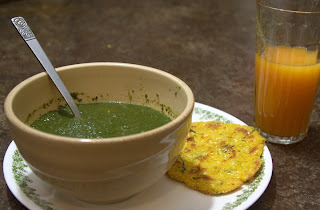My house mates Andy and Andrew and I usually go running on Monday mornings, and after several very solid farm challenge meals so far, we felt we had adequate energy reserves to do our regular run. Upon returning, Andrew fried up some sweet potato hash browns and served them up with 2 of our precious eggs[1] and some Duncan grapefruit.
Monday lunch
Lunch, cooked by Jen, consisted of leftover rabbit wraps (this time using blanched kale as the wrappers), accompanied by a green papaya salad. You've probably never had that before, so let me assure you that it is delicious. Green papaya is not very flavorful, so it makes a great base to other flavors. Here, the papaya was grated, blanched, and then tossed with lemon-lime juice, jicama, bunching onions, hot 'Indian firecracker' peppers, cherry tomatoes, salt, and olive oil.
Monday dinner
I wanted to use some of my urban garden mustard greens in cooking dinner, so I made food inspired by an Indian blended greens dish called Sarsoon ka saag (or just saag for short). This dish is traditionally accompanied by corn pancakes called Makki di roti. I didn't have all the right spices to make this dish authentically, but got as close as I could[2]. Here's how you do it:
1. Start with a big pile of greens:
 |
| New Zealand spinach (Tetragonia tetragonioides) in the front, mustard greens in the back. |
 |
| Cinnamon leaves, curry leaf, bunching onions, garlic chives, and jalapeño peppers. Turmeric to follow. |
4. The corn pancake are a mix of corn flour, chopped cilantro, salt, and hot water. Make patties and fry them in a pan. Making the patties is difficult unless you are Punjabi, in which case you can make it look really easy. Mine ended up a lot smaller and fatter.
We served these together with a papaya-grapefruit-mint juice, prepared by Andrew:
---
Reflections, day 2: Another good day of satisfying meals, featuring substitutions (sweet potato -> potato) as well as completely unfamiliar dishes.
We're definitely noticing that food is commanding greater proportion of our time and thoughts than it normally does. When all your ingredients start out in the garden, planning, harvesting, preparing and cooking meals can easily take several hours. In our case, this is not time we always have available during our lunch break or late afternoons. Thankfully we worked ahead last week; the corn was already ground and the papayas grated, blanched and frozen. It's evident, though, how much the industrialization of our food supply has reduced how invested we are in our daily meals. And not only in terms of money.
---
[1] Eggs, another alternate protein source, are in short supply this year. Andrews ducks and my chickens aren't laying, and LauraCatherine's are only popping out 3 or so a day.
[2] Almost every published recipe I could find online was followed by dozens of angry comments berating the chef for "not being a real Punjabi." I'm still not sure how Saag is "supposed" to be cooked, but apparently neither does anyone else on the internet. If anyone knows, let me know!






Great point: "..the industrialization of our food supply has reduced how invested we are in our daily meals." I am in complete agreement on this point. I would like to come along side the interns during farm week next year, and eat from produce of my land. Much preparation is needed.
ReplyDelete